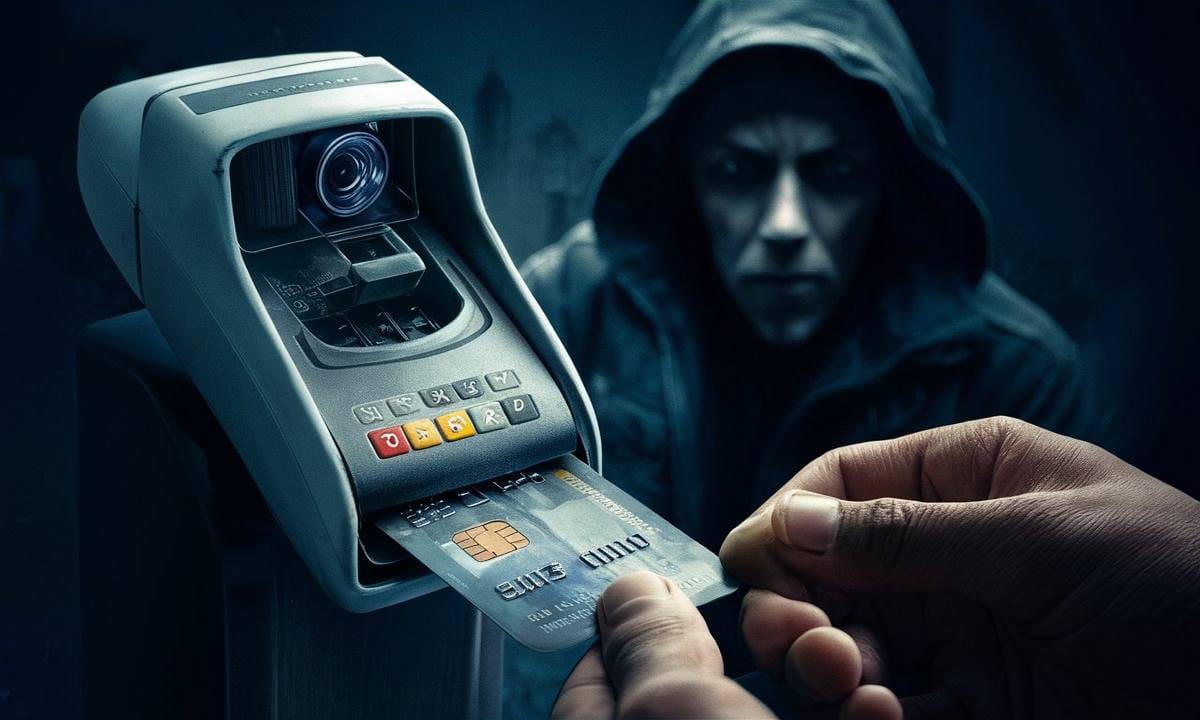In an era where digital transactions are commonplace, credit card skimmers represent a serious and growing threat. These covert devices are designed to steal sensitive financial information, potentially leading to significant losses for consumers. Understanding how skimmers operate and how to protect oneself is essential for safeguarding personal and financial security.

The Rise of Card Skimming: An Overview of the Threat
Card skimming has evolved from a relatively obscure crime to a prevalent and sophisticated threat. Criminals use advanced technology to exploit vulnerabilities in payment systems, resulting in substantial financial harm to individuals. As skimming techniques become more sophisticated, the importance of awareness and vigilance has never been greater.
Why Understanding Credit Card Skimmers is Crucial for Consumers
Knowledge is the first line of defense against skimming. By understanding what credit card skimmers are and how they work, consumers can take proactive steps to protect their financial information. Awareness helps in recognizing suspicious activities and in implementing preventive measures, thus reducing the risk of becoming a victim.

The Evolution of Skimming Technology
Skimming technology has undergone significant advancements since its inception. Early skimmers were rudimentary devices, but modern versions are highly sophisticated, incorporating wireless capabilities and advanced data capture techniques. This evolution reflects the ongoing cat-and-mouse game between criminals and security professionals.
Defining Credit Card Skimmers
What Exactly is a Credit Card Skimmer?
A credit card skimmer is a device designed to capture card information surreptitiously during a transaction. Typically, these devices are installed on ATMs, gas station pumps, or retail point-of-sale systems. They read and record the magnetic stripe data from credit or debit cards without the knowledge of the cardholder.
Different Types of Skimmers: Physical vs. Digital
Skimmers can be categorized into physical and digital types. Physical skimmers are tangible devices attached to card readers, while digital skimmers involve malicious software that intercepts data during online transactions. Each type poses unique challenges and requires different strategies for detection and prevention.
How Skimmers Have Evolved Over Time
Skimmers have transitioned from simple overlays to complex devices equipped with wireless technology. Early skimmers were bulky and easily detectable, but modern versions are slim and integrate seamlessly with existing equipment, making them much harder to spot.
The Mechanics of Credit Card Skimmers
How Do Credit Card Skimmers Capture Your Information?
Skimmers capture card information by reading the magnetic stripe on a card when it is swiped or inserted. This data includes the card number, expiration date, and other sensitive information. Some skimmers also capture PIN numbers through hidden cameras or keyloggers.
Exploring the Technology Behind Skimmers
Advanced skimmers employ sophisticated technology to capture and transmit data. Wireless skimmers, for example, use Bluetooth or cellular networks to send stolen information to criminals in real-time. The technology behind skimmers continues to evolve, posing ongoing challenges for detection and prevention.
How Skimmers Transmit Stolen Data to Criminals
Skimmers transmit stolen data using various methods, including wireless communication and physical retrieval of stored data. Some devices send data directly to a nearby receiver, while others store it on internal memory for later extraction. This transmission process is crucial for criminals to use the stolen information effectively.

Common Places Where Skimmers are Installed
ATM Machines: A Prime Target for Skimmers
ATMs are a common target for skimmers due to their widespread use and accessibility. Skimmers installed on ATMs can capture both card information and PINs, making them highly effective for fraudsters. The relative anonymity of ATM transactions also makes them attractive targets.
Gas Station Pumps: Hidden Dangers in Plain Sight
Gas station pumps are another popular location for skimmers. These devices are often hidden within or around the pump, camouflaged to blend with the equipment. As consumers pay for fuel, their card information is surreptitiously captured by the skimmer.
Retail Locations: How Skimmers are Used in Stores
In retail environments, skimmers can be installed on point-of-sale terminals or card readers. These skimmers capture card information during everyday purchases, exploiting the high volume of transactions. Retail skimmers are often sophisticated and designed to be inconspicuous.
Types of Skimming Devices
Overlay Skimmers: What They Are and How They Work
Overlay skimmers are designed to fit over existing card readers, capturing data as cards are swiped. They are typically thin, making them difficult to detect. The overlay fits seamlessly over the legitimate card reader, making it challenging for consumers to notice any discrepancies.
Deep Insert Skimmers: Harder to Detect, More Dangerous
Deep insert skimmers are installed inside card readers, making them less visible but more dangerous. These devices can capture both card data and PIN numbers directly from the card’s magnetic stripe, increasing the risk of fraud.
Wireless Skimmers: The Next Level of Stealth
Wireless skimmers use advanced technology to transmit stolen data without the need for physical retrieval. These devices can communicate with a nearby receiver via Bluetooth or other wireless methods, making them particularly challenging to detect and thwart.
Identifying the Signs of a Skimmer
Physical Clues That a Skimmer is Present
Physical signs of a skimmer include unusual attachments to card readers, loose or damaged components, and unfamiliar devices near payment terminals. Consumers should be alert to these indicators and inspect equipment carefully before use.
Behavioral Red Flags: When to Be Suspicious
Behavioral red flags include difficulties when inserting or swiping a card, unexpected delays during transactions, and unfamiliar prompts or messages. These signs may indicate the presence of a skimmer and warrant caution.
High-Risk Locations: Where You’re Most Likely to Encounter Skimmers
Certain locations are more prone to skimming, such as poorly lit ATM areas, outdated gas station pumps, and high-traffic retail stores. Awareness of these high-risk locations can help consumers remain vigilant and avoid potential skimming incidents.
The Role of Software Skimmers
Understanding Malware-Based Skimmers
Malware-based skimmers, or software skimmers, are used to intercept data during online transactions. These malicious programs can be embedded in compromised websites or apps, capturing sensitive information as users enter payment details.
How Software Skimmers Are Used in Online Transactions
Software skimmers operate by capturing data from online payment forms or during digital transactions. They can be deployed through phishing schemes or malicious software, targeting unsuspecting users and compromising their financial information.
Protecting Yourself from Digital Skimming Threats
To protect against digital skimming, use secure websites, employ strong passwords, and regularly monitor financial statements. Employing robust cybersecurity practices can mitigate the risk of falling victim to online skimming.
The Impact of Skimming on Consumers
Financial Losses: The Immediate Consequences of Skimming
Victims of skimming often experience immediate financial losses due to unauthorized transactions. Prompt action is necessary to mitigate these losses and protect one’s financial well-being.
Long-Term Effects: Identity Theft and Credit Damage
In addition to immediate financial losses, skimming can lead to identity theft and long-term credit damage. Victims may face difficulties in securing credit and may need to undertake extensive recovery efforts.
How Skimming Incidents Affect Consumer Trust
Frequent skimming incidents can undermine consumer trust in financial institutions and payment systems. Addressing these concerns requires transparency and proactive measures from both institutions and consumers.
How to Protect Yourself from Credit Card Skimmers
Practical Steps for Detecting and Avoiding Skimmers
To avoid skimmers, inspect card readers for tampering, use ATMs and gas pumps in well-lit areas, and cover the keypad when entering your PIN. Remaining vigilant and cautious can help prevent skimming incidents.
Best Practices for Using ATMs and Gas Pumps Safely
Use ATMs and gas pumps with visible security features, avoid using machines that appear altered, and regularly check account statements for unusual activity. These best practices enhance security and reduce the risk of skimming.
The Importance of Regularly Monitoring Your Accounts
Regularly monitoring financial accounts is essential for detecting unauthorized transactions early. Prompt reporting of suspicious activity can help prevent further damage and facilitate quick resolution.
The Role of Financial Institutions in Preventing Skimming
How Banks are Fighting Back Against Skimming Threats
Banks employ various strategies to combat skimming, including advanced security measures, real-time monitoring, and customer education. Collaboration between consumers and financial institutions is crucial for effective skimming prevention.
The Importance of EMV Chip Technology in Reducing Skimming
EMV chip technology improves card security by generating unique transaction codes for each purchase. This makes it difficult for skimmers to capture usable data, significantly reducing skimming incidents.
Consumer Education: Empowering Customers to Stay Safe
Educating consumers about skimming risks and prevention measures is vital. Awareness campaigns and resources help individuals recognize and respond to potential threats effectively.
What to Do If You Suspect a Skimmer
Immediate Actions to Take After Spotting a Skimmer
If a skimmer is suspected, avoid using the compromised device, report the issue to the relevant authorities, and monitor financial accounts for unusual activity. Swift action can help mitigate potential damage.
How to Report Skimming Incidents to Authorities
Report skimming incidents to local law enforcement, financial institutions, and relevant regulatory bodies. Prompt reporting facilitates investigation and helps prevent further incidents.
Steps to Take If Your Information Has Been Compromised
If personal information has been compromised, take steps to protect your identity, such as freezing credit reports, contacting financial institutions, and filing a police report. These actions can help mitigate the impact of skimming.
The Legal Consequences for Skimming Offenders
Laws and Regulations Surrounding Credit Card Skimming
Credit card skimming is illegal and subject to severe penalties under various laws and regulations. Legal frameworks aim to deter skimming activities and provide recourse for affected individuals.
How Law Enforcement is Tackling Skimming Operations
Law enforcement agencies employ specialized units to investigate and prosecute skimming operations
. Collaborative efforts between agencies and financial institutions enhance the effectiveness of these investigations.
The Potential Penalties for Those Caught Skimming
Penalties for skimming can include substantial fines, imprisonment, and restitution to victims. The severity of penalties reflects the serious nature of skimming crimes and the commitment to enforcing legal standards.
The Future of Credit Card Skimming
Emerging Technologies That Could Combat Skimming
Emerging technologies, such as biometric authentication and advanced encryption, hold promise for combating skimming. These innovations aim to enhance security and reduce vulnerabilities in payment systems.
Predictions for How Skimmers Will Evolve in the Coming Years
As technology advances, skimmers are likely to become more sophisticated and harder to detect. Anticipating these changes can help in developing proactive strategies to address future threats.
How Consumers Can Stay Ahead of Future Threats
To stay ahead of future skimming threats, consumers should stay informed about emerging technologies and security practices. Continued vigilance and adaptation to evolving threats are key to maintaining financial security.
Case Studies: Real-Life Skimming Incidents
Notable Skimming Scandals and Their Impact
Examining notable skimming scandals provides insight into the scale and impact of skimming operations. These cases highlight the importance of robust security measures and consumer awareness.
Lessons Learned from Major Skimming Cases
Major skimming cases offer valuable lessons in identifying vulnerabilities and improving security practices. Analyzing these incidents can inform better strategies for preventing and responding to skimming.
How Businesses Can Protect Themselves and Their Customers
Businesses can protect themselves and their customers by implementing advanced security measures, conducting regular inspections, and educating employees and customers. These proactive steps enhance overall security and mitigate the risk of skimming.
BOTTOM LINE
The Importance of Vigilance in the Fight Against Skimming
Vigilance is crucial in the ongoing fight against skimming. By staying informed, adopting best practices, and collaborating with financial institutions, individuals and businesses can effectively combat skimming threats.
Key Takeaways for Protecting Your Financial Information
Key takeaways include regular monitoring of accounts, awareness of potential skimming devices, and prompt reporting of suspicious activity. These practices are essential for safeguarding financial information and preventing losses.
Final Thoughts on Staying Safe in a World of Evolving Threats
In a world where skimming threats continue to evolve, staying safe requires constant vigilance and adaptation. By understanding the risks and implementing effective security measures, individuals and businesses can protect themselves from the ever-changing landscape of financial crime.
Frequently Asked Questions (FAQs)
How can I spot a credit card skimmer on an ATM or gas pump?
To spot a credit card skimmer, look for unusual attachments or modifications on the card reader, such as an overlay or extra piece on the ATM or gas pump. Inspect the card slot and keypad for any signs of tampering or loose components. Compare the device with similar machines to see if anything seems out of place.
For more information, check this source.
What are the signs of a credit card skimmer?
Signs of a credit card skimmer include:
- Unusual attachments or devices on card readers.
- Loose or damaged components on ATMs or gas pumps.
- Unusual behavior, such as difficulty inserting your card or unexpected delays.
- Tampered or out-of-place security seals or stickers.
For detailed guidance, see this article.
How can I avoid using a compromised card reader?
To avoid using a compromised card reader, inspect the device before use, ensuring there are no suspicious attachments or tampered parts. Use ATMs and gas pumps in well-lit, high-traffic areas and avoid machines that appear altered or have unusual components. If you have doubts, use a different machine.
What should I do if I suspect a credit card skimmer was used on my card?
If you suspect a skimmer was used, immediately report the issue to your bank or credit card issuer. Monitor your account for unauthorized transactions and consider placing a fraud alert on your credit report. Additionally, file a police report if necessary.
Are there specific locations where credit card skimmers are more common?
Credit card skimmers are more commonly found at ATMs, gas station pumps, and retail locations with self-service card readers. These high-traffic areas are prime targets due to their accessibility and the volume of transactions.
Can chip-enabled cards prevent credit card skimming?
Chip-enabled cards, also known as EMV cards, provide enhanced security features that make it harder for skimmers to capture and use your card information. The dynamic data generated by EMV chips for each transaction reduces the risk of card data theft compared to magnetic stripe cards.
How can I protect myself from credit card skimmers?
Protect yourself from credit card skimmers by regularly monitoring your account for unauthorized transactions, using ATMs and gas pumps in well-lit areas, and inspecting card readers for signs of tampering. Additionally, consider using mobile payment apps or credit cards with EMV chips for added security.
What should I do if my card information is stolen by a skimmer?
If your card information is stolen, report the theft to your card issuer immediately to block the card and prevent further unauthorized transactions. Monitor your accounts closely, update your passwords, and consider placing a fraud alert on your credit report.
How do credit card skimmers capture your card information?
Credit card skimmers capture information by reading the magnetic stripe on your card when it is swiped or inserted. Some skimmers also capture PINs through hidden cameras or overlay devices that record keystrokes during PIN entry.
Can mobile payment apps help avoid credit card skimming?
Yes, mobile payment apps can help avoid credit card skimming by using encryption and tokenization to protect your payment information. These apps often generate unique transaction codes that are less susceptible to skimming compared to traditional card transactions.
Are there apps or devices that can detect credit card skimmers?
Yes, there are apps and devices designed to detect credit card skimmers. Some smartphone apps can help identify suspicious activity or detect compromised card readers. Additionally, specialized devices can be used to scan and identify potential skimming devices.
What should I do if I notice suspicious activity on my credit card statement?
If you notice suspicious activity on your credit card statement, immediately report it to your credit card issuer. Provide details of the unauthorized transactions, and request a replacement card if necessary. Monitor your account closely for any further unusual activity.
How do thieves install credit card skimmers on machines?
Thieves install credit card skimmers by physically tampering with card readers, such as overlaying or embedding skimming devices onto ATMs or gas pumps. They may also use small tools to insert skimmers into existing equipment or use wireless technology to retrieve data.
How effective are security cameras in deterring credit card skimming?
Security cameras can be effective in deterring credit card skimming by providing surveillance that may discourage criminals from installing skimmers. They also help in investigating and identifying perpetrators if a skimming incident occurs.
What are the latest technologies in detecting and preventing credit card skimming?
The latest technologies in detecting and preventing credit card skimming include advanced encryption methods, real-time transaction monitoring, and enhanced security features such as biometric authentication. These technologies aim to enhance overall security and reduce vulnerabilities.
Are there any steps businesses can take to protect their customers from skimmers?
Businesses can protect customers from skimmers by regularly inspecting and maintaining payment equipment, implementing advanced security measures like EMV technology, and educating staff and customers about skimming risks. Regularly updating and patching software can also help prevent skimming attacks.
Can using a credit card instead of a debit card reduce the risk of skimming?
Using a credit card instead of a debit card can reduce the risk of skimming because credit cards generally offer better fraud protection and are less directly linked to your bank account. This makes it easier to address and recover from unauthorized transactions.
How often should I check my account for unauthorized transactions?
You should check your account for unauthorized transactions at least once a week. Regular monitoring helps you quickly identify and address any suspicious activity, reducing the risk of financial loss and identity theft.
What laws or regulations exist to combat credit card skimming?
Laws and regulations to combat credit card skimming include various state and federal statutes that criminalize the act of installing skimmers and using stolen card information. The Fair Credit Billing Act (FCBA) and other regulations provide protections for consumers and outline the legal consequences for offenders.









